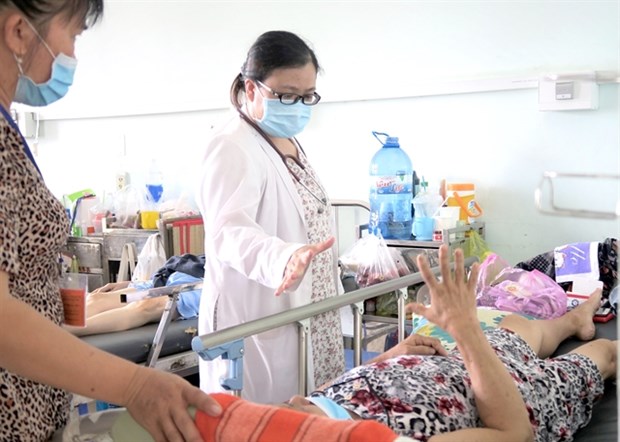
Thousands of stroke patients hospitalised in Ho Chi Minh City's People's Hospital 115 over the past three years have been saved by RAPID, an artificial intelligence software.
Thousands of stroke patients hospitalised in Ho Chi Minh City's People's Hospital 115 over the past three years have been saved by RAPID, an artificial intelligence software.
 |
| A stroke patient survived at HCM City's People's Hospital 115 thanks to using the AT software RAPID. |
Nguyen Huy Thang, head of the hospital's Cerebrovascular Disease Department, said about 1,000 stroke cases survive each year thanks to using RAPID, instead of only 400 cases in previous years.
Described as a "hidden killer", stroke is the third leading cause of death after cancer and cardiovascular disease in Vietnam. Notably, stroke among young people has continued to increase in recent years.
In order to improve quality and effectiveness in treatment and care of stroke patients, since 2019, People's Hospital 115 was the first hospital in the country to apply RAPID to take blood clots to treat cerebral infarction for stroke patients hospitalised after six hours of symptoms.
RAPID, developed by US-based Stanford University, is being used in more than 40 countries around the world.
The “golden” time to treat stroke is in the first six hours from onset, he said.
Patients who do not recanalide large cerebral blood vessels during this period are at risk of death or severe disability.
Patients who come to the hospital after six hours could be refused intervention by the doctor because they could not determine how much the risk area in the patient's brain was damaged.
“In addition, removing the blood clots in these cases is both too dangerous and expensive,” Thang said.
With conventional imaging techniques, the doctor can only see the necrotic brain parenchyma, but not the brain area that will be dead in the next few hours.
Seeing the brain area that will be dead is very important to help doctors make appropriate treatment indications to save the patient's life, and reduce the risk of disability.
“RAPID can help to quantify brain lesions. It provides physicians with fast, fully automated, and easy to interpret imaging,” he said.
“If the patient's entire brain is necrotic, the patient has no chance of survival, but if they still have salvageable brain tissue, the doctors will remove the blood clots to save the patient," he said.
However, most stroke patients arrive at the hospital too late to take advantage of treatment and care. This is one of the main reasons leading to high rate of deaths and disability caused by stroke.
People's Hospital 115 recorded around 12% of stroke patients hospitalised in the first four to five hours after the onset symptoms, 30% of them are hospitalised after the first six hours, and 60% of them are hospitalised within 24 hours.
Using RAPID could help to extend the golden time for medical intervention from six hours after onset of a stroke to up to 24 hours, Thang said.
“That brings more opportunities to save the lives of a huge number of stroke patients hospitalised late,” he said.
Each year Vietnam has about 200,000 stroke cases. Although there have been advanced technologies and modern equipment, the survival rate of stroke cases is only 50%.
There is evidence that stroke in the young is increasing, especially in patients under 35 years old.
Stroke is a dangerous acute illness, often occurring suddenly, with a high death rate if not detected early and treated promptly.
Therefore, it is very important to raise awareness for people to adopt preventive methods of stroke.
Thang advised that people with hypertension and diabetes are at high risk of a stroke, and need to monitor their health condition to prevent a possible stroke.
In addition, people should increase physical activity and limit the use of alcohol, tobacco and other drugs to prevent the risks of stroke.
If a person has signs of stroke such as weakness on one side of the body, facial nerve paralysis, headaches, dizziness, vision loss and slurred speech, they should immediately visit hospitals or health-care facilities to reduce risks of death and serious complications.
(Source: VNA)





